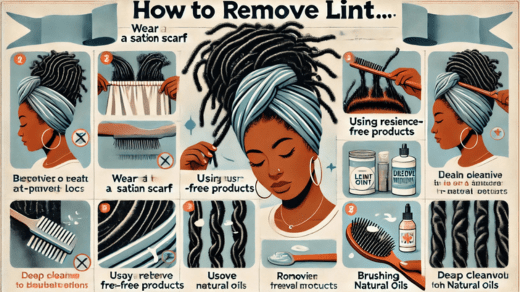How to Prevent and Remove Lint from Locs: A Complete Guide

Locs are a beautiful and low-maintenance hairstyle, but they can sometimes attract lint, which can be difficult to remove. Lint buildup in locs can come from clothing, bedding, or even hair products, making your locs look dull and unkempt. If you’re struggling with lint in your locs or want to prevent it from happening, this guide will provide you with practical solutions.
Why Does Lint Get Stuck in Locs?
Lint is made up of tiny fibers from fabrics, dust, and product buildup. Since locs have a naturally textured structure, they easily trap these fibers, making lint difficult to remove once embedded.
Common Causes of Lint in Locs:
- Clothing and Bedding: Towels, hoodies, sweaters, and pillowcases shed tiny fibers that can get trapped in your locs.
- Product Buildup: Heavy creams, butters, and oils can attract and hold onto lint, making it harder to wash out.
- Dry Hair: Dry locs are more likely to absorb lint, so keeping them moisturized is key.
- Environmental Factors: Airborne dust, pet hair, and even pollution can contribute to lint accumulation.
To minimize lint, check out this detailed guide on keeping locs clean.
How to Remove Lint from Locs
If you’ve already noticed lint in your locs, don’t worry—there are ways to get rid of it. The sooner you address the issue, the easier it will be to remove.
1. Use a Fine-Tooth Comb or Tweezers
For surface-level lint, try gently pulling it out with tweezers or a fine-tooth comb.
- Work carefully so you don’t cause breakage.
- If lint is deep inside the loc, avoid pulling too hard, as this can damage the hair.
2. Apple Cider Vinegar Rinse
An ACV rinse helps break down buildup and loosen lint trapped in your locs.
- Mix one part apple cider vinegar with two parts warm water in a bowl.
- Soak your locs for 5-10 minutes, then rinse with water.
- Follow with a deep cleanse to remove any remaining debris.
3. Baking Soda & Clarifying Shampoo
A deep cleanse with baking soda and shampoo can help lift lint from locs.
- Mix 1 tablespoon of baking soda with your clarifying shampoo and apply it to your hair.
- Let it sit for a few minutes before rinsing thoroughly.
4. Lint Removal Tools
A reusable lint roller or a Portable Electronic Lint Remover can be used to gently roll over your locs and lift off lint without damaging the hair. These tools work best on surface lint that hasn’t been embedded too deeply.
How to Prevent Lint from Getting in Your Locs
While removing lint is possible, prevention is always better. Here are some simple ways to stop lint from building up in your locs:
1. Wear a Satin or Silk Scarf at Night
Sleeping on cotton pillowcases or using rough blankets can lead to lint buildup. Instead, use a satin or silk scarf or sleep with a satin pillowcase to protect your locs.
2. Choose Lint-Free Clothing
Certain fabrics, like fleece and wool, shed more lint. Opt for materials that don’t attract as much lint, such as satin, silk, or high-quality cotton.
3. Wash and Moisturize Your Locs Regularly
Keeping your locs clean and moisturized prevents them from becoming dry and sticky, which can attract lint. Use a lightweight, residue-free oil to hydrate your locs without making them sticky.
4. Avoid Heavy Products
Creamy or sticky hair products can act like a magnet for lint. Instead, use lightweight oils or sprays to keep your locs moisturized without attracting debris.
For more detailed loc care, check out this comprehensive guide to loc maintenance.
Final Thoughts
Lint in locs can be frustrating, but with the right prevention and removal techniques, you can keep your hair looking clean and fresh. By choosing the right fabrics, using gentle cleaning methods, and maintaining proper hair care routines, you can prevent lint from taking over your locs.
For those dealing with stubborn lint, tools like a Portable Electronic Lint Remover or a Reusable Lint Roller can help keep your locs lint-free without damage.
If you want to learn more about keeping your locs in top shape, check out this full guide on maintaining lint-free locs.




